
The myth of the good man, untainted in his natural state, Jean Jacques Rousseau's ideal figure, was thought of as that man in a primitive condition, alien to all political and social structures, in essence pure.
In Arango's paintings appear those primitive creatures: the naked bodies, the animals, the jaguar and the frog and the starry skies. It is that diaphanous gaze that evokes the myth of a clean and pure world. However, all is not well in paradise: the serpent, the archetypal representation of original sin and evil, coils around a tree; the death of the bull reveals human conflict and evil. Arango takes form to its simplest state. He plays with color, matter, scale, proportions, and directions. Perhaps it is then the very nature of painting that allows Arango to reveal and preserve its "natural state".
The good savage is a metaphor of hope, for it is not yet too late for man to remember his origins and recover the ideals of a better world, one in which the diaphanous and innocent gaze recreates the world in all its splendor.
La Balsa Arte began its activities in 2014 in the La Macarena neighborhood, occupying a space in the Torres del Parque, a heritage building in Bogota. Its objective was to represent, promote and exhibit the work of national artists, Colombian artists living abroad and international artists whose work reflects research processes in contemporary issues. Research in art refers to the undertaking of any systematic activity whose objective is to expand the frontiers of understanding and knowledge, both aesthetic and in the social sciences, the relationship between culture and society, history and the development of today's world.
Considering that the field of art is a powerful tool to think, confront or reinterpret the relationships of a globalized world, La Balsa Arte has focused on maintaining a close conversation with artists of various generations.
In its years of activity, La Balsa Arte has sponsored the participation of its artists in fairs, cultural exchanges, residencies and logistical support for production.
The gallery currently has two locations. In Medellín it opened its doors in 2017, recovering a house from the 30s of the twentieth century, with a history linked to the arts in the city, in Bogotá it moved to a location in the north of the city, close to hotels, restaurants and financial centers.

If reviewed within the western historical canons, the work of Diego Arango has a clear influence on avant-garde movements of the 20th century such as surrealism, abstraction, cubism and primitivism. Regarding the latter, Arango highlights its simplicity, its transcendence in time and its reverence for form. It is important to emphasize that these European avant-gardes spread throughout Latin America, which not only generated a transformation and appropriation of these movements with a nationalist vision, but also a renewal and positioning of Latin American art at a global level. Arango was born in Medellín and was formed as an architect at the National University. More than 40 years ago he settled in Palma de Mallorca, a territory that has colored his work, not only from the colorful Mediterranean, but also from the simple life, the sea, the sun and the free and multicultural spirit that is breathed there. Added to this is his interest in the mythical and the archetypal imaginaries that result from his experiences and his interest in the primitive. In his paintings, Arango addresses in a determined and committed way, his interest in flat forms, color, space, but also in the rudimentary, play and chaos. Far from a subjective reading, his work points towards the universality of language that results from the refined forms of the representation of things. Subject that enhances the expressive, dreamlike capacity and the power of art to reverse the order of reality, without his paintings pretending to be more than the representation of what they are: joyful and antidogmatic.
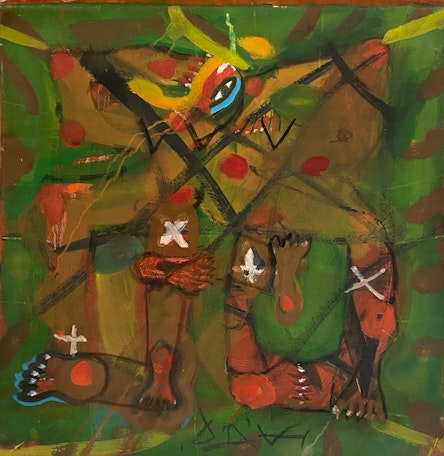
If reviewed within the western historical canons, the work of Diego Arango has a clear influence on avant-garde movements of the 20th century such as surrealism, abstraction, cubism and primitivism. Regarding the latter, Arango highlights its simplicity, its transcendence in time and its reverence for form. It is important to emphasize that these European avant-gardes spread throughout Latin America, which not only generated a transformation and appropriation of these movements with a nationalist vision, but also a renewal and positioning of Latin American art at a global level. Arango was born in Medellín and was formed as an architect at the National University. More than 40 years ago he settled in Palma de Mallorca, a territory that has colored his work, not only from the colorful Mediterranean, but also from the simple life, the sea, the sun and the free and multicultural spirit that is breathed there. Added to this is his interest in the mythical and the archetypal imaginaries that result from his experiences and his interest in the primitive. In his paintings, Arango addresses in a determined and committed way, his interest in flat forms, color, space, but also in the rudimentary, play and chaos. Far from a subjective reading, his work points towards the universality of language that results from the refined forms of the representation of things. Subject that enhances the expressive, dreamlike capacity and the power of art to reverse the order of reality, without his paintings pretending to be more than the representation of what they are: joyful and antidogmatic.
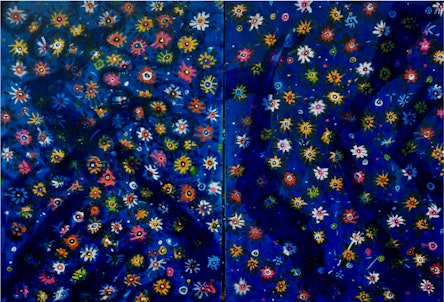
If reviewed within the western historical canons, the work of Diego Arango has a clear influence on avant-garde movements of the 20th century such as surrealism, abstraction, cubism and primitivism. Regarding the latter, Arango highlights its simplicity, its transcendence in time and its reverence for form. It is important to emphasize that these European avant-gardes spread throughout Latin America, which not only generated a transformation and appropriation of these movements with a nationalist vision, but also a renewal and positioning of Latin American art at a global level. Arango was born in Medellín and was formed as an architect at the National University. More than 40 years ago he settled in Palma de Mallorca, a territory that has colored his work, not only from the colorful Mediterranean, but also from the simple life, the sea, the sun and the free and multicultural spirit that is breathed there. Added to this is his interest in the mythical and the archetypal imaginaries that result from his experiences and his interest in the primitive. In his paintings, Arango addresses in a determined and committed way, his interest in flat forms, color, space, but also in the rudimentary, play and chaos. Far from a subjective reading, his work points towards the universality of language that results from the refined forms of the representation of things. Subject that enhances the expressive, dreamlike capacity and the power of art to reverse the order of reality, without his paintings pretending to be more than the representation of what they are: joyful and antidogmatic.
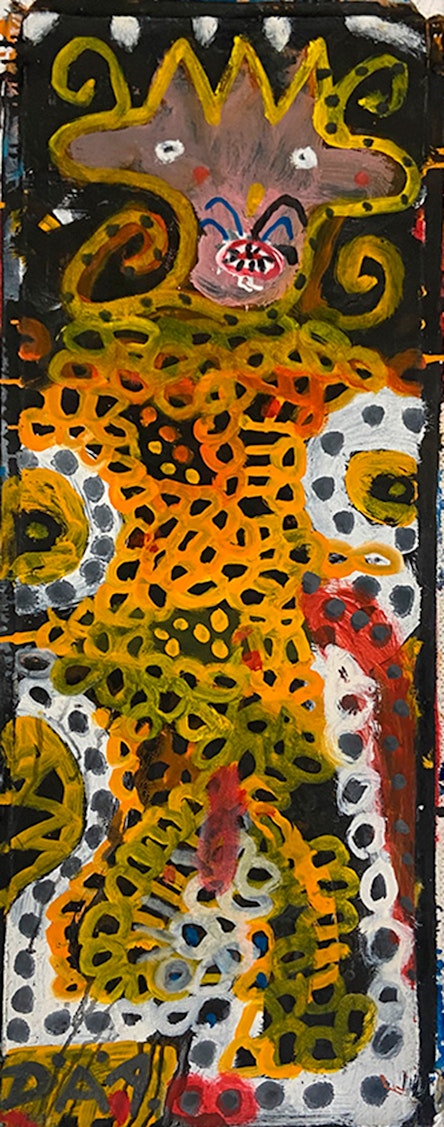
If reviewed within the western historical canons, the work of Diego Arango has a clear influence on avant-garde movements of the 20th century such as surrealism, abstraction, cubism and primitivism. Regarding the latter, Arango highlights its simplicity, its transcendence in time and its reverence for form. It is important to emphasize that these European avant-gardes spread throughout Latin America, which not only generated a transformation and appropriation of these movements with a nationalist vision, but also a renewal and positioning of Latin American art at a global level. Arango was born in Medellín and was formed as an architect at the National University. More than 40 years ago he settled in Palma de Mallorca, a territory that has colored his work, not only from the colorful Mediterranean, but also from the simple life, the sea, the sun and the free and multicultural spirit that is breathed there. Added to this is his interest in the mythical and the archetypal imaginaries that result from his experiences and his interest in the primitive. In his paintings, Arango addresses in a determined and committed way, his interest in flat forms, color, space, but also in the rudimentary, play and chaos. Far from a subjective reading, his work points towards the universality of language that results from the refined forms of the representation of things. Subject that enhances the expressive, dreamlike capacity and the power of art to reverse the order of reality, without his paintings pretending to be more than the representation of what they are: joyful and antidogmatic.
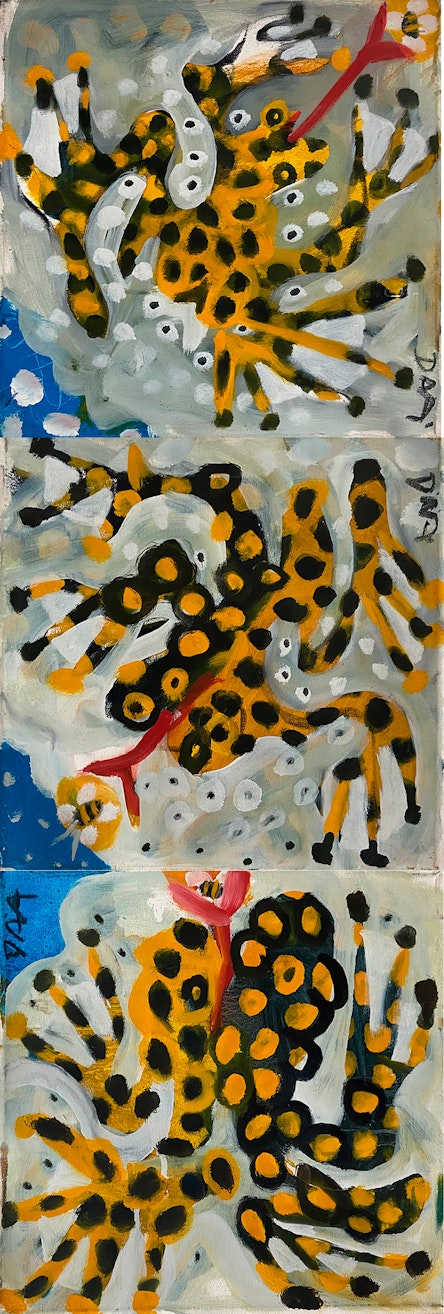
If reviewed within the western historical canons, the work of Diego Arango has a clear influence on avant-garde movements of the 20th century such as surrealism, abstraction, cubism and primitivism. Regarding the latter, Arango highlights its simplicity, its transcendence in time and its reverence for form. It is important to emphasize that these European avant-gardes spread throughout Latin America, which not only generated a transformation and appropriation of these movements with a nationalist vision, but also a renewal and positioning of Latin American art at a global level. Arango was born in Medellín and was formed as an architect at the National University. More than 40 years ago he settled in Palma de Mallorca, a territory that has colored his work, not only from the colorful Mediterranean, but also from the simple life, the sea, the sun and the free and multicultural spirit that is breathed there. Added to this is his interest in the mythical and the archetypal imaginaries that result from his experiences and his interest in the primitive. In his paintings, Arango addresses in a determined and committed way, his interest in flat forms, color, space, but also in the rudimentary, play and chaos. Far from a subjective reading, his work points towards the universality of language that results from the refined forms of the representation of things. Subject that enhances the expressive, dreamlike capacity and the power of art to reverse the order of reality, without his paintings pretending to be more than the representation of what they are: joyful and antidogmatic.
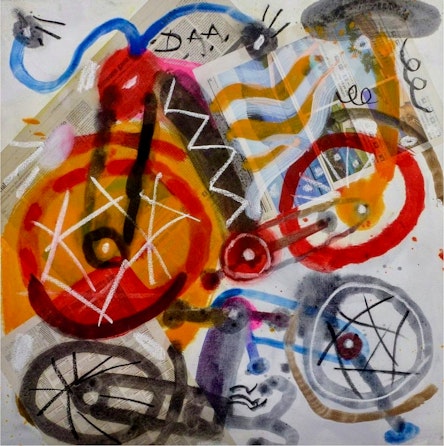
If reviewed within the western historical canons, the work of Diego Arango has a clear influence on avant-garde movements of the 20th century such as surrealism, abstraction, cubism and primitivism. Regarding the latter, Arango highlights its simplicity, its transcendence in time and its reverence for form. It is important to emphasize that these European avant-gardes spread throughout Latin America, which not only generated a transformation and appropriation of these movements with a nationalist vision, but also a renewal and positioning of Latin American art at a global level. Arango was born in Medellín and was formed as an architect at the National University. More than 40 years ago he settled in Palma de Mallorca, a territory that has colored his work, not only from the colorful Mediterranean, but also from the simple life, the sea, the sun and the free and multicultural spirit that is breathed there. Added to this is his interest in the mythical and the archetypal imaginaries that result from his experiences and his interest in the primitive. In his paintings, Arango addresses in a determined and committed way, his interest in flat forms, color, space, but also in the rudimentary, play and chaos. Far from a subjective reading, his work points towards the universality of language that results from the refined forms of the representation of things. Subject that enhances the expressive, dreamlike capacity and the power of art to reverse the order of reality, without his paintings pretending to be more than the representation of what they are: joyful and antidogmatic.
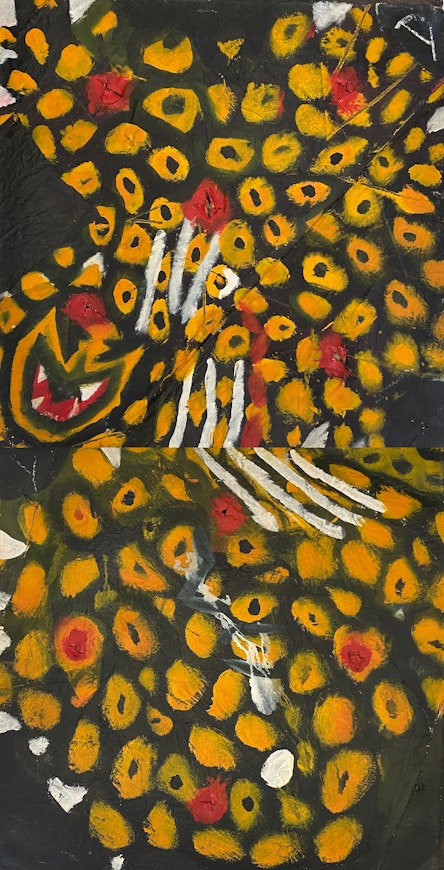
If reviewed within the western historical canons, the work of Diego Arango has a clear influence on avant-garde movements of the 20th century such as surrealism, abstraction, cubism and primitivism. Regarding the latter, Arango highlights its simplicity, its transcendence in time and its reverence for form. It is important to emphasize that these European avant-gardes spread throughout Latin America, which not only generated a transformation and appropriation of these movements with a nationalist vision, but also a renewal and positioning of Latin American art at a global level. Arango was born in Medellín and was formed as an architect at the National University. More than 40 years ago he settled in Palma de Mallorca, a territory that has colored his work, not only from the colorful Mediterranean, but also from the simple life, the sea, the sun and the free and multicultural spirit that is breathed there. Added to this is his interest in the mythical and the archetypal imaginaries that result from his experiences and his interest in the primitive. In his paintings, Arango addresses in a determined and committed way, his interest in flat forms, color, space, but also in the rudimentary, play and chaos. Far from a subjective reading, his work points towards the universality of language that results from the refined forms of the representation of things. Subject that enhances the expressive, dreamlike capacity and the power of art to reverse the order of reality, without his paintings pretending to be more than the representation of what they are: joyful and antidogmatic.
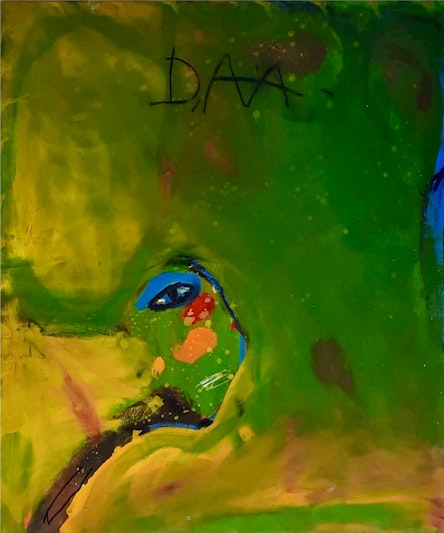
If reviewed within the western historical canons, the work of Diego Arango has a clear influence on avant-garde movements of the 20th century such as surrealism, abstraction, cubism and primitivism. Regarding the latter, Arango highlights its simplicity, its transcendence in time and its reverence for form. It is important to emphasize that these European avant-gardes spread throughout Latin America, which not only generated a transformation and appropriation of these movements with a nationalist vision, but also a renewal and positioning of Latin American art at a global level. Arango was born in Medellín and was formed as an architect at the National University. More than 40 years ago he settled in Palma de Mallorca, a territory that has colored his work, not only from the colorful Mediterranean, but also from the simple life, the sea, the sun and the free and multicultural spirit that is breathed there. Added to this is his interest in the mythical and the archetypal imaginaries that result from his experiences and his interest in the primitive. In his paintings, Arango addresses in a determined and committed way, his interest in flat forms, color, space, but also in the rudimentary, play and chaos. Far from a subjective reading, his work points towards the universality of language that results from the refined forms of the representation of things. Subject that enhances the expressive, dreamlike capacity and the power of art to reverse the order of reality, without his paintings pretending to be more than the representation of what they are: joyful and antidogmatic.
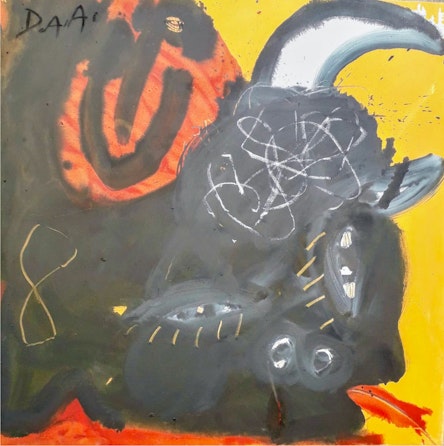
If reviewed within the western historical canons, the work of Diego Arango has a clear influence on avant-garde movements of the 20th century such as surrealism, abstraction, cubism and primitivism. Regarding the latter, Arango highlights its simplicity, its transcendence in time and its reverence for form. It is important to emphasize that these European avant-gardes spread throughout Latin America, which not only generated a transformation and appropriation of these movements with a nationalist vision, but also a renewal and positioning of Latin American art at a global level. Arango was born in Medellín and was formed as an architect at the National University. More than 40 years ago he settled in Palma de Mallorca, a territory that has colored his work, not only from the colorful Mediterranean, but also from the simple life, the sea, the sun and the free and multicultural spirit that is breathed there. Added to this is his interest in the mythical and the archetypal imaginaries that result from his experiences and his interest in the primitive. In his paintings, Arango addresses in a determined and committed way, his interest in flat forms, color, space, but also in the rudimentary, play and chaos. Far from a subjective reading, his work points towards the universality of language that results from the refined forms of the representation of things. Subject that enhances the expressive, dreamlike capacity and the power of art to reverse the order of reality, without his paintings pretending to be more than the representation of what they are: joyful and antidogmatic.
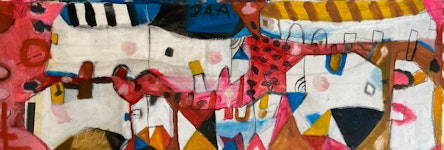
If reviewed within the western historical canons, the work of Diego Arango has a clear influence on avant-garde movements of the 20th century such as surrealism, abstraction, cubism and primitivism. Regarding the latter, Arango highlights its simplicity, its transcendence in time and its reverence for form. It is important to emphasize that these European avant-gardes spread throughout Latin America, which not only generated a transformation and appropriation of these movements with a nationalist vision, but also a renewal and positioning of Latin American art at a global level. Arango was born in Medellín and was formed as an architect at the National University. More than 40 years ago he settled in Palma de Mallorca, a territory that has colored his work, not only from the colorful Mediterranean, but also from the simple life, the sea, the sun and the free and multicultural spirit that is breathed there. Added to this is his interest in the mythical and the archetypal imaginaries that result from his experiences and his interest in the primitive. In his paintings, Arango addresses in a determined and committed way, his interest in flat forms, color, space, but also in the rudimentary, play and chaos. Far from a subjective reading, his work points towards the universality of language that results from the refined forms of the representation of things. Subject that enhances the expressive, dreamlike capacity and the power of art to reverse the order of reality, without his paintings pretending to be more than the representation of what they are: joyful and antidogmatic.